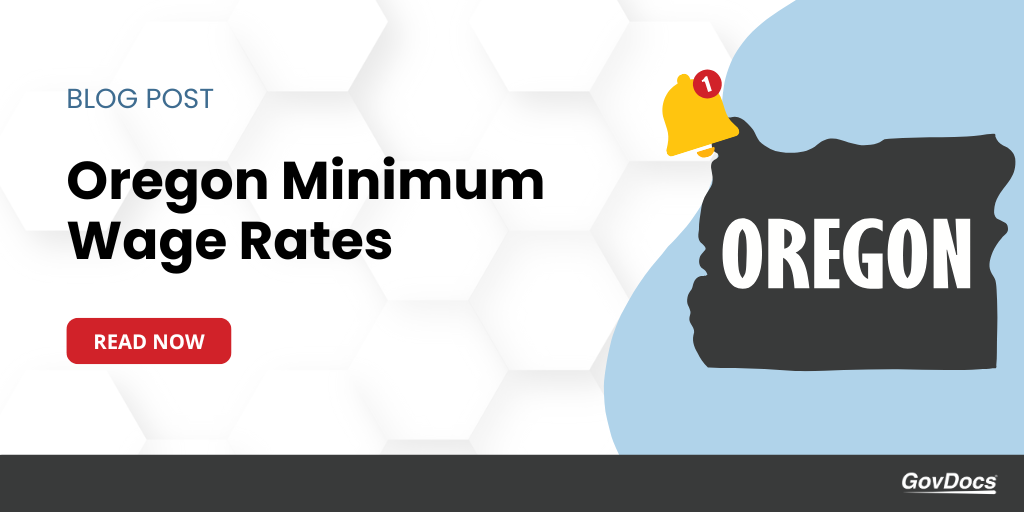EMPLOYMENT LAW NEWS
Oregon Minimum Wage in 2025
By GovDocs
Updated June 2025

With indexed rates on the horizon, compliance teams should ensure they have the correct Oregon minimum wage rates applied to their locations.
Oregon minimum wage could take the title as the most unique minimum wage system in the United States.
Minimum wage in Oregon is generally applied by county — the more densely populated an area is, the higher the rate.
But the rates don’t perfectly align with county boundaries, which makes tracking and applying the correct minimum wage especially cumbersome for employers with locations in Oregon.
What is the 2025 minimum wage in Oregon?
Oregon minimum wage has three separate rates. Since 2023, the Oregon minimum wage rates increase based on inflation every July 1.
Effective July 1, 2025, Oregon’s minimum wage rates are:
- Portland metro – $16.30
- Standard – $15.05
- Non-urban – $14.05
Again, though, the rates aren’t applied evenly across counties.
Oregon minimum wage breaks down as follows
$16.30 per hour – Portland metro
Areas within the urban growth boundary, including parts of Clackamas, Multnomah and Washington counties.
$15.05 per hour – Standard
Benton, Clatsop, Columbia, Deschutes, Hood River, Jackson, Josephine, Lane, Lincoln, Linn, Marion, Polk, Tillamook, Wasco, Yamhill, and parts of Clackamas, Multnomah and Washington outside the urban growth boundary.
$14.05 per hour – Non-urban
Baker, Coos, Crook, Curry, Douglas, Gilliam, Grant, Harney, Jefferson, Klamath, Lake, Malheur, Morrow, Sherman, Umatilla, Union, Wallowa and Wheeler counties.
Note, the state does not have separate rates for tipped employees.
How do you track Oregon’s Minimum Wage with Employees Working in Multiple Counties?
In the era of nontraditional work environments, applying minimum wage rates can be tricky. Oregon’s minimum wage law outlines how the it applies to employees who work in counties with different rates.
For employees who work at a fixed business location:
- If an employee performs more than 50 percent of their work in a pay period at the employer’s permanent fixed location in Oregon, the applicable minimum wage rate is determined based on the region where the business is located
- If an employee makes deliveries as a part of their job and starts and ends work at the employer’s permanent fixed location, the minimum wage rate is the applicable rate for the region where the business is located
For employees who work somewhere other than the employer’s fixed business location:
- If an employee performs 50 percent or less of their work at that location, “the region in which the employee performs work is considered to be the employer’s location for purposes of determining the applicable minimum wage rate to be paid”
- If an employee performs work in more than one regionin a pay period, the employer must pay either:
(1) the applicable minimum wage rate for each hour worked in each region where the employee worked during the pay period; or
(2) the highest minimum wage rate required for any region in which the employee worked for all hours worked by the employee during the pay period
- If an employee performs work in more than one region in a pay period, the employer must also maintain records of the locations unless they pay the highest rate for all hours worked by the employee during the pay period
If you need a solution that helps you monitor minimum wage in Oregon between multiple counties, check out: GovDocs Minimum Wage Rate Management.
This Employment Law News blog is intended for market awareness only, it is not to be used for legal advice or counsel.
Keep Informed
with GovDocs Employment Law News
Who is GovDocs?
GovDocs is a leading provider of employment law compliance solutions, empowering HR professionals to navigate complex, location-specific labor law postings, minimum wage requirements, and paid leave laws. GovDocs combines innovative technology with dedicated human-touch support to deliver worry-free compliance. Customers benefit from access to a centralized system, trusted resources, and expert employment law support they need, all in one place, to simplify compliance and protect their organization from risk. Trusted by over 35% of Fortune 500 companies, GovDocs focuses on comprehensive coverage of Federal, State, City, and County laws making employment law management seamless for organizations of all sizes. Join the evolution of employment law compliance here!
The GovDocs Poster Store simplifies posting compliance for employers with less than 30 locations across all industries, offering a variety of posting products to meet your labor law compliance needs.





